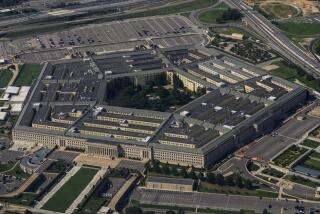Recommended: more advisors
- Share via
WASHINGTON — For more than a year, U.S. commanders have agreed on the need to assign advisors to Iraqi military units to help them secure their country and allow American troops gradually to withdraw. But only about 5,000 of the 135,000 American military in Iraq are now engaged as full-time advisors.
In one of its clearest recommendations Wednesday, the Iraq Study Group called for the military to greatly expand this effort. Boosting the number of advisors to as many as 20,000, the group said, could enable the U.S. military to send home most combat units by early 2008.
But more training would not necessarily make Iraq safer or pave the way for a quick and clean American withdrawal, caution military experts, who noted that the advisory mission is tricky.
Without the backing of nearby combat brigades, embedding with Iraqi units could be highly dangerous for soldiers and Marines.
Military officers and analysts say that the lessons of Iraq -- and of Vietnam -- have shown that combat brigades can be withdrawn only after advisors have helped improve the military might of Iraqi units.
“The U.S. combat brigades are currently keeping a lid on the violence in the country,” said Stephen Biddle, a former professor at the U.S. Army War College and fellow at the Council on Foreign Relations.
He said that if combat units are withdrawn, insurgents’ use of roadside bombs “will skyrocket, the civilian death rate will increase. And yet we are going to keep a bunch of troops in the country. Those convoys are going to roll through Indian country with no cavalry.”
The American experience in Vietnam provides a cautionary lesson. An emphasis on combat advisors dramatically improved the prowess of the South Vietnamese army in the closing years of the Vietnam War. But some U.S. military scholars have argued that a sharp three-year drawdown in combat troops undermined the progress that the military advisors were making.
And in Iraq, efforts to reduce the number of combat brigades deployed in the country have not gone smoothly. Army Gen. George W. Casey Jr., commander of U.S. forces in Iraq, laid out a plan earlier this year to gradually withdraw combat brigades on a timeline very similar to that presented by the Iraq Study Group. The plan was shelved when violence in Baghdad spiked this summer, and U.S. commanders were forced to draw in more forces.
Further complicating matters is the suspect combat readiness of the Iraqi military. The Iraq Study Group’s report says there are doubts about the “ethnic composition and loyalties” of Iraqi units and questioned their leadership, equipment and manpower.
These problems illustrate why simply increasing the number of embedded American trainers is not going to instantly transform the Iraqi army or police into a capable fighting force. The units have little combat motivation and little national identity.
“There is a whole collection of barriers to Iraqi military institutions that aren’t readily solvable by spending more time on a firing range with an American sergeant,” Biddle said.
So far, the training of the Iraqi forces has gone slowly. Even units with intense help from a variety of U.S. forces, including embedded trainers who live and work with the Iraqis, have needed more than a year to be able to handle basic, small-unit counterinsurgency operations.
Currently there are supposed to be about 12 Americans embedded in each Iraqi battalion of several hundred soldiers; the military is considering doubling this number.
By advocating up to 20,000 advisors, the Iraq Study Group is proposing to quadruple that number, which would give each Iraqi company a significant advisory team.
Only about 50,000 of the U.S. soldiers and Marines in Iraq are combat infantrymen. Most, about 80,000, are logistics and support personnel such as communications specialists, supply teams and medical workers.
Former U.S. Sen. Charles S. Robb, a member of the Iraq Study Group, described the proposed sharp increase in embedded military advisors coupled by a gradual drawdown in combat forces as “a dramatic change in the way we have been doing business” -- but the Pentagon has been pursuing such a strategy for more than year.
Largely unnoticed in Washington, the Army has been transforming Ft. Riley, a sprawling facility in eastern Kansas, into a vast training base for military advisors since February. The first class of advisors arrived at Ft. Riley for the 60-day training course in June, and military planners anticipate the program will be churning out 2,000 embeds per class by March.
The Marines at Camp Pendleton have their own 120-day training program for advisors that includes language and cultural classes and instruction on how to work and live with Iraqi units.
“The trainers the Marine Corps sends over there embed with the [Iraqi] unit,” said Col. Jeff Vold, the officer in charge of the advisor training. “They live with them ... they patrol with them, they eat together, they do everything together. They try to become one with the Iraqis.”
Critics have argued that the program took far too long to implement.
Ad hoc advisory teams were organized by some of the first division commanders in Iraq as early as 2003, but it took nearly three years for the Pentagon to formalize the program, leading to inadequate training of advisors and unmotivated training teams.
Gen. Peter J. Schoomaker, the Army chief of staff, has made staffing the teams a top priority, adding incentives in April to induce the military’s best officers to volunteer for the program. The Iraq Study Group called for further measures to ensure the most qualified personnel are sent to the program.
Officers involved in the program acknowledge that, despite the new incentives, the soldiers being sent as advisors are still a mixed lot.
“We’ve got some pretty good people, but it is still not the best and brightest in all cases. We have some work to do there,” Brig. Gen. Dana Pittard, the Army officer sent to Iraq in June to help revamp the advisor program, said in a recent interview. “Right now, if you are a lieutenant colonel, you want to come over here as a battalion commander, not necessarily as an advisor.”
*
peter.spiegel@latimes.com
More to Read
Sign up for Essential California
The most important California stories and recommendations in your inbox every morning.
You may occasionally receive promotional content from the Los Angeles Times.










